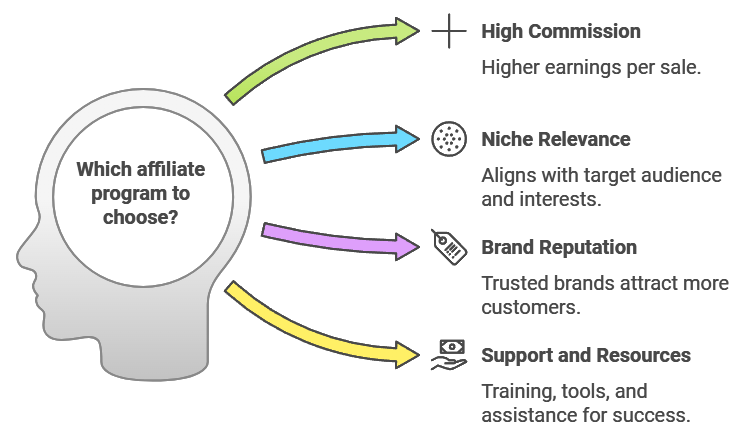Estimated reading time: 14 minutes
Did you know? The affiliate marketing industry is projected to grow to a staggering $27.78 billion by 2027, with a compound annual growth rate of 9.89%. Even more exciting, 80% of brands report that affiliate marketing plays a crucial role in their revenue generation. That’s right! More people are jumping into this booming industry to earn money by promoting products and services they love. So, how can you become part of this massive growth and achieve financial freedom?
Let’s break it down. Affiliate marketing is essentially a partnership where you, as the affiliate, promote someone else’s product and earn a commission for every sale made through your unique referral link. It’s a win-win situation—businesses increase their sales while you get rewarded for driving traffic and generating leads. No need for warehouses or shipping hassles; you focus on marketing, and the rest is handled by the seller. Sounds super cool, right?
But here’s the catch—choosing the right affiliate program is key to your success. Not every program is created equal, and finding the one that aligns with your niche, goals, and audience is crucial. In this blog post, we’ll guide you step-by-step through the process of selecting the best affiliate programs for your business and setting up a thriving affiliate marketing strategy. Ready to dive in? Let’s go!

Understanding Affiliate Programs
Affiliate marketing can take different forms depending on how merchants set up their programs. Let’s dive into the two main types:
Types of Programs
- In-House Programs
In-house programs are where merchants manage their own affiliate programs directly. They take full control over everything from approvals and commissions to tracking and payouts. Think of big players like Amazon Associates or the eBay Partner Network—both operate their own in-house affiliate programs. This type of program often means more direct communication and greater flexibility in negotiating commissions or promotional tactics. If you’re looking to build strong, direct relationships with merchants, this could be the super cool route to take! - Affiliate Networks
Affiliate networks are third-party platforms that connect affiliates with multiple merchants at once. Platforms like ShareASale, CJ (formerly Commission Junction), and ClickBank allow you to manage multiple partnerships all in one place. This setup makes it easier to find different programs within your niche, diversify your earnings, and save time on management. Networks are perfect if you prefer one-stop shopping for affiliate opportunities and want access to a broader range of products.
Commission Structures
Understanding how you’ll get paid is crucial in affiliate marketing. Let’s break down the main types of commission structures so you can decide which one aligns best with your goals:
- Pay-per-Sale (PPS)
This is the most common and straightforward commission model. You, as the affiliate, earn a percentage of each sale generated through your referral link. For example, if someone clicks your link and makes a purchase, you get a slice of the sale—boom! 💰 It’s a win-win model that rewards you directly based on your sales performance. So, the more you sell, the more you earn! - Pay-per-Action (PPA)
In this model, you earn a commission when a specific action is completed. It could be a lead, sign-up, app download, or even a survey completion. PPA commissions are perfect if your audience isn’t ready to buy but is interested in trying things out. It’s a broader approach to earning that can suit various niches, especially if you’re targeting audiences who are in the research phase of their buying journey. - Recurring Commissions
Now, this one’s the real deal for creating passive income. 🤑 With recurring commissions, you earn ongoing payments for each subscription or membership referral. Think of services like SaaS platforms, membership sites, or monthly subscription boxes. As long as your referral keeps paying, you keep earning. It’s like setting up your own little money machine that keeps running as long as customers stay subscribed.
Key Terminology
Affiliate marketing comes with its own lingo, and knowing these key terms is essential for your success. Learn more about affiliate marketing terminology here. Let’s break them down in simple terms:
- Commission Rate
This is the percentage or fixed amount you’ll earn from each sale or action. For example, if a program offers a 20% commission rate, you’ll pocket 20% of the sale price. The higher the commission rate, the more you earn for each sale—super simple, right? Just keep an eye on rates to ensure they’re worth your marketing efforts. - Cookie Duration
This refers to how long your referral link stays active. Imagine you promote a product, and someone clicks your link but doesn’t buy immediately. The cookie duration determines how long that sale can still be credited to you if they return to buy later. It’s like having a safety net that keeps working for you—whether it’s 7 days, 30 days, or even 90 days. A longer cookie duration gives you a better chance to earn commissions. - Payment Threshold
This is the minimum amount you need to earn before receiving a payout. For example, if the threshold is $50, you won’t get paid until your commissions hit that mark. It’s a bit like reaching the goal line before cashing in. Make sure the threshold aligns with your expected earnings to avoid long waits for payouts.
Factors to Consider When Choosing an Affiliate Program
When diving into affiliate marketing, not all programs will be the perfect fit. Here’s what you should prioritize when evaluating affiliate programs. Learn more about choosing the right program here.
Product/Service Relevance
- Alignment with Your Niche
It’s all about relevance! Make sure the products you promote align with your niche and resonate with your audience. Your followers trust you for your specific expertise, so it makes sense to pick products that complement your content. For example, if you run a health and wellness blog, promoting fitness gear or nutrition products would be an ideal fit. - Product/Service Quality
Your reputation is everything, so partnering with reputable businesses is non-negotiable. High-quality products help maintain trust with your audience, ensuring they have positive experiences. If your audience loves what you recommend, it builds your credibility and opens the door to even more conversions and repeat sales. - Year-Round Demand
Consistent demand means consistent earnings! Search for products that have year-round appeal rather than being seasonal or trendy. For instance, promoting a subscription box service or evergreen products like software tools can provide steady income, as they fulfill ongoing needs and interests of your audience.

Program Features and Terms
When choosing an affiliate program, you’ve got to dig into the details to ensure you’re getting the most out of your efforts. Here are some must-check factors:
- Commission Rate and Structure
Look for programs offering competitive commission rates that align with your earning goals. Higher commission rates mean more money in your pocket for each sale, while a solid structure ensures you’re getting paid fairly, whether it’s per sale, per lead, or recurring. Go for programs that match your strategy and sales expectations! - Cookie Duration
The longer, the better! A longer cookie duration increases your chances of earning commissions, especially if your audience takes time to decide before purchasing. It’s like giving your referral link a longer shelf life—more time, more sales! - Payment Methods and Threshold
No one likes waiting forever to get paid! Choose programs with convenient payment methods (like PayPal or direct bank deposits) and reasonable payment thresholds. If you’re hitting the threshold consistently, it means your earnings are flowing smoothly. - Traffic Leaks
Be wary of landing pages with traffic leaks that divert potential sales away from your referral links. Some landing pages might have pop-ups or links that guide visitors elsewhere before they convert. This can hurt your chances of making sales—so always check for a clean, conversion-focused design. - Terms and Conditions
Read the fine print! Always review the program’s terms and conditions to understand any restrictions on promotional activities, traffic sources, or payment terms. Knowing what’s allowed (and what’s not) keeps your marketing strategy compliant and your earnings safe.
Program Management and Support
To thrive in affiliate marketing, you need programs that are not just “set it and forget it.” You want real support and solid management features that drive your growth. Here’s what to look for:
- Tracking System
A top-notch tracking system is non-negotiable. It should accurately monitor your performance, attribute sales correctly, and give you real-time insights. You need to know exactly which strategies are working and which aren’t, so you can tweak them for better results. The better the tracking, the clearer your roadmap to earning more commissions. - Communication and Support
Having a responsive affiliate manager is like having a coach in your corner. Look for programs with active support channels—whether it’s email, chat, or even a direct line to an affiliate manager. Quick answers to your questions mean fewer headaches and faster adjustments to your strategy. It’s all about keeping your momentum strong. - Training and Resources
The best programs offer training materials, promotional assets, and other resources to help you succeed. Whether it’s ready-to-use banners, email templates, or step-by-step guides, these tools make it easier to promote and convert. You’re not just partnering with a brand—you’re teaming up with a support system designed to boost your success. So, go for programs that have your back!
Strategies for Success: Building a Thriving Affiliate Marketing Business
Want to turn your affiliate marketing efforts into a full-fledged business? It’s all about building relationships, delivering real value, and maintaining transparency. Check out these proven strategies that can elevate your affiliate marketing game.

Building Long-Term Affiliate Relationships
- Open Communication
Strong relationships start with clear communication. Establish open channels with affiliate program managers, ask questions, and promptly address any concerns. Whether it’s about tracking, payments, or promotional tactics, maintaining a two-way dialogue helps you get the most out of the partnership. - Delivering Value
It’s not just about pushing links—it’s about providing genuine value to your audience. Focus on generating high-quality traffic and boosting conversions by creating content that resonates with your followers. When your audience benefits from the products you recommend, you become a valuable partner in the eyes of affiliate managers, paving the way for even better opportunities. - Ethical Marketing and Transparency
Be transparent with your audience about your affiliate relationships. Clearly disclose when you’re earning commissions, as this builds trust and credibility. Ethical marketing keeps you compliant and strengthens your bond with followers, making them more likely to convert.
Content Creation for Affiliate Marketing
Content is the backbone of affiliate marketing. The more engaging and helpful your content is, the better it will perform. Here’s how to master content creation and maximize your conversions:
- Content Strategy
Start by developing a solid content plan that aligns with your niche, target audience, and chosen affiliate products. Think about what your audience cares about most, then craft content that addresses their needs, solves their problems, or enhances their lives. For example, if you’re in the health niche, focus on content that promotes fitness tools, supplements, or wellness guides. Your strategy should ensure each piece of content drives value and makes your readers feel like they’re getting something meaningful. - Content Formats
Don’t stick to one type of content—variety is key! Experiment with formats like:- Product Reviews: Give an honest breakdown of a product’s pros and cons.
- Tutorials: Show step-by-step how to use a product effectively.
- Comparisons: Compare similar products to help readers make informed choices.
- Case Studies: Share real-life results from using a product or service.
- Listicles: Create lists of top products, tools, or services in your niche.
- Email Newsletters: Send curated content directly to your subscribers with strategic affiliate links.
- Mixing these formats keeps your content fresh, engaging, and more likely to convert.
- SEO and Keyword Research
To attract organic traffic, optimize your content for search engines. Do thorough keyword research to find terms your audience is searching for. Use tools like Google Keyword Planner, Ahrefs, or Ubersuggest to find high-ranking keywords related to your products. Sprinkle these keywords naturally throughout your content—especially in titles, headings, and meta descriptions. When your content ranks well, more potential buyers find it, driving more clicks and conversions. - Content Promotion and Distribution
Don’t just create content—promote it like a pro! Share your content across social media platforms, use email lists, collaborate with influencers, and leverage other relevant channels to amplify your reach. The more eyes you get on your content, the more potential clicks you generate. Use a mix of organic reach, paid ads, and influencer partnerships to keep traffic flowing to your affiliate links.
Analyzing and Optimizing Performance
Tracking your performance isn’t just about checking numbers—it’s about unlocking growth and maximizing profitability. Here’s how to keep your affiliate marketing efforts on track:
- Performance Tracking
To know what’s working (and what’s not), you need to regularly monitor key metrics like:- Clicks: Track how many people are clicking on your affiliate links.
- Conversions: Measure how many of those clicks turn into actual sales or leads.
- Earnings per Click (EPC): Analyze how much you’re earning for every click on your links.
- Return on Investment (ROI): Calculate your ROI to ensure your marketing efforts are yielding more money than you’re putting in.
- By keeping an eye on these metrics, you’ll get a clear picture of which strategies are bringing in results—and which ones need a revamp.
- A/B Testing
Don’t settle for “good enough.” Experiment with different promotional approaches, calls to action, landing pages, and content formats to see what drives the highest conversions. Try different headlines, button colors, and even page layouts to find the winning combination. Remember, small tweaks can lead to big results—so always be testing! - Continuous Improvement
Data is your best friend in affiliate marketing. Regularly analyze the numbers, identify areas for improvement, and adapt your strategies accordingly. Whether it’s reworking underperforming content or reallocating resources to high-converting channels, always be on the lookout for ways to boost profitability. Success in affiliate marketing is all about refining your approach and evolving with the data.
Conclusion
You’ve made it this far, and now you’re equipped with everything you need to master affiliate marketing! Let’s quickly recap the key takeaways:
- Choosing the Right Program: Find programs that align with your niche, offer competitive commissions, and provide strong support.
- Building Relationships: Establish open communication with program managers, deliver value, and maintain ethical transparency.
- Creating Content that Converts: Develop a strategic content plan, use various formats, optimize for SEO, and promote across multiple channels.
- Analyzing and Optimizing Performance: Regularly track your metrics, run A/B tests, and continuously refine your strategies for maximum results.
Now it’s your turn! The world of affiliate marketing is full of opportunities, and you’re just one step away from getting started. Dive into some recommended networks, test a few programs, and start creating content that converts. Remember, the sooner you begin, the sooner you can start earning!
FAQ Section
1. What is affiliate marketing, and how does it work?
Answer: Affiliate marketing is a business model where individuals (affiliates) promote products or services of a company and earn a commission for each sale made through their referral link. Affiliates use various marketing strategies like content creation, social media, and email campaigns to drive traffic to the merchant’s site, earning commissions based on sales or specific actions.
2. How do I choose the best affiliate program for my niche?
Answer: To choose the best affiliate program for your niche, consider factors like product relevance, commission structure, cookie duration, and program support. Ensure the products align with your audience’s interests and offer competitive commissions. Additionally, look for programs with longer cookie durations, reliable tracking, and strong support systems.
3. What are the most effective content formats for affiliate marketing?
Answer: The most effective content formats for affiliate marketing include product reviews, tutorials, comparisons, listicles, case studies, and email newsletters. These formats allow you to highlight product benefits, provide step-by-step guidance, and compare options, helping users make informed decisions while boosting your conversions.
4. How can I improve my affiliate marketing performance?
Answer: Improving affiliate marketing performance involves regular tracking of metrics like clicks, conversions, and earnings per click (EPC). Use A/B testing to experiment with different calls to action, landing pages, and promotional tactics. Analyzing results and continuously optimizing your strategy helps maximize profitability and growth.
5. Is affiliate marketing suitable for beginners?
Answer: Yes, affiliate marketing is suitable for beginners. It requires minimal upfront investment, and many programs offer resources and support to help affiliates get started. Beginners can start by promoting products that align with their interests and focus on content creation, SEO, and social media to drive traffic and earn commissions.











Leave a Reply